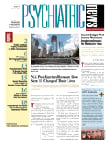Researchers might learn more about autism if they could study it prospectively in the general population. One way to do that is to screen all children as early as 1 year of age, before symptoms appear.
The American Academy of Pediatrics recommended in 2007 that pediatricians conduct surveillance for autism spectrum disorders at every well-child visit and screen children at 18 and 24 months, or when parents raise concerns. But earlier screening might be valuable for the child and researchers alike.
Much research on autism now looks at younger siblings of children diagnosed with the disorder.
"Screening very young children would also allow research to better study the trajectory of the disorder," said Amy Wetherby, Ph.D., a professor in the School of Communication Science and Disorders at Florida State University, in an interview.
Also, early screening might help children identified as having autism spectrum disorders if they then could be evaluated and given access to treatment, wrote Karen Pierce, Ph.D., an assistant adjunct professor in the Department of Neurosciences at the University of California, San Diego, and colleagues in the July Pediatrics.
Pierce began by recruiting 137 pediatricians in San Diego County, beginning in 2005 and continuing for another three and a half years. After a seminar on autism, the doctors and their staffs learned how to use and score a screening test given to all infants at the 1-year well-baby checkup.
They used the Communication and Symbolic Behavior Scales Developmental Profile Infant-Toddler Checklist (CSBS-DP-IT-Checklist), a 24-item test designed to detect developmental delay, language delay, and autism.
Babies who scored below developmental norms were referred for further evaluation and treatment.
The pediatricians screened 10,479 babies, of whom 1,318 failed the screen. Of those, 346 were referred to Pierce's group for evaluation. The rest of the failures may not have been referred because of lack of follow-through by the pediatricians, referral to a different organization, or the pediatrician's perception that the child did not need an evaluation.
Alternatively, some parents may have refused further testing and treatment for unspecified reasons, said the authors.
Ultimately, the researchers followed 184 at-risk children for an average of six half-yearly visits. Pediatricians randomly selected a control group of 66 children who passed the screening test.
Of all the babies screened, 32 were eventually diagnosed with autism spectrum disorders, 56 with a learning delay, and nine with a developmental delay. All of the babies with autism spectrum disorders or learning delays and 89 percent of those with developmental delays were referred for behavioral treatment, beginning at 17 months of age, on average.
Starting treatment early could offer significant benefits to affected children, compared with those who are diagnosed at around age 3, said Pierce.
Other experts are not so certain that routine screening for autism spectrum disorders is ready for prime time.
"[W]e believe that community screening of all preschoolers is premature," wrote Mona Al-Qabandi, M.D., of Kuwait's Mubarak Al-Kabeer Hospital, and Jan Willem Gorter, M.D., Ph.D., and Peter Rosenbaum, M.D., both of the Department of Pediatrics at McMaster University in Hamilton, Ontario.
They argued that while awareness of autism has increased, screening tools are still under development, and therapies have not been proven very efficacious.
"These conclusions raise a fundamental question: what do we aim to achieve when we screen for a nonpreventable condition for which there are no well-validated intervention strategies?" they said.
Analyses by Zachary Warren, M.D., Jeremy Veenstra-Vander Weele, M.D., and colleagues previously published in Pediatrics indicated benefits of some forms of treatment (Psychiatric News, May 6).
"While we are happy to read in the Warren paper that they have observed ‘some’ improvements in ‘some aspects of function’ in ‘some’ children, we strongly believe that there is a considerable lack of convincing evidence that our current management strategies are powerful enough to warrant universal application and a population-wide screening program for autism spectrum disorders," Gorter told Psychiatric News. "We need to know which treatments work to help improve which aspects of function in which subgroups of children."
Wetherby, who developed the CSBS-DP-IT-Checklist, believes that screening has value for research and clinical care, even if it so far lacks 99 percent specificity and sensitivity.
"Screening for autism is a process, not a tool," Wetherby told Psychiatric News. "Doctors look at how indicators change over time."
Much ongoing research into both screening and treatment is adding to the evidence base, she said.
Population screening is not now mandated, but it should be a goal, said Alice Kau, Ph.D., a health scientist administrator in the Intellectual and Developmental Disabilities Branch of the National Institute of Child Health and Development in Bethesda, Md.
Currently, several trials of different screening instruments are under way, and the field will benefit by having more than one tool on the market, said Kau in an interview.
"We can't wait until the dust settles," she said. "We have to work harder to do population screening."
Lower-income and minority children are now diagnosed later than other children and will suffer if screening is not formalized, she said.

